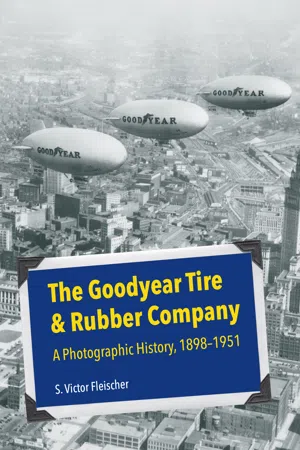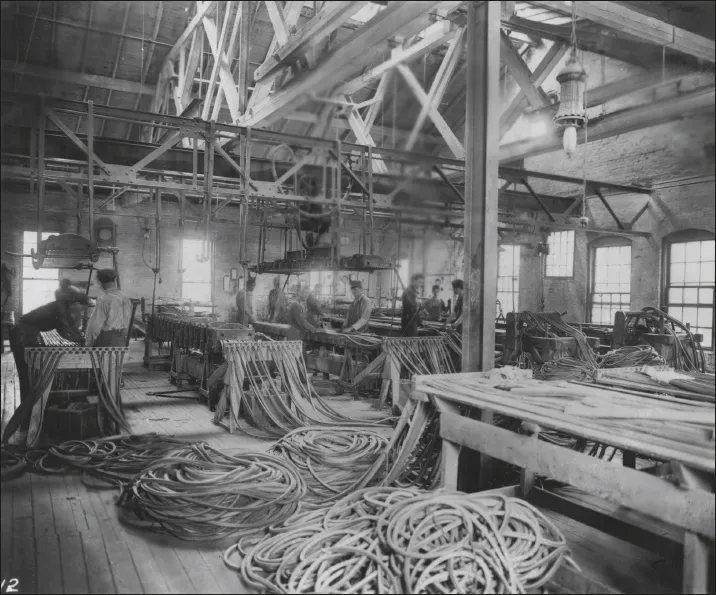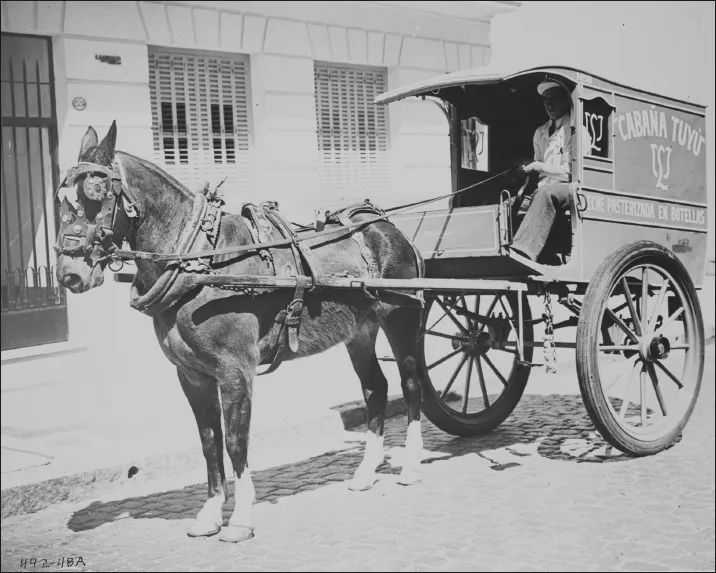![]()
Chapter 1
Where the Rubber Meets the Road
Carriage, Car, and Cycle Tires
“The rubber tire was the foundation of Goodyear’s business career, the thing that made it a great company.”1
—Hugh Allen, Goodyear publicist
In 1898, when the Seiberlings opened the doors to The Goodyear Tire & Rubber Company, they chose to manufacture only three products: carriage tires, bicycle tires, and automotive tires. The first products to roll off the production lines—on November 21, 1898—were solid tires for carriages and bicycles. Their first sale occurred on December 1, 1898, and came to a total of $251.80. Goodyear exclusively produced carriage and bicycle tires its inaugural year, but three years later, the company added automobile tires to their lineup, and the venture quickly expanded. Less than 20 years later, tire sales totaled $64 million, and Goodyear became “the No. 1 company in tires.”2 By the start of the Great Depression, the rubber company had an estimated capacity of 75,000 tires a day, or approximately 26 percent of the total field. By the end of World War II, Goodyear manufactured tires for numerous modes of transportation. In many of these lines, they invented new products and processes that helped transform the industry.3
Thousands of images in The Goodyear Tire & Rubber Company Collection document the corporation’s contributions to the tire industry and showcase the variety of tires, tubes, and rims designed and manufactured by the company. The images illustrate almost every aspect of tire development, including studio shots of the tires, cross sections, drawings, advertisements, tire damage, and competitors’ products. They also show tire testing, the stages of tire manufacturing, and tire builders—both male and female. The images capture Goodyear tires on different modes of transportation, such as carriages, automobiles, bicycles, and motorcycles. Some of the photographs show vehicles important to the history of transportation that are now considered antique or classic automobiles—including Duesenbergs, Packards, Hudsons, and rare vehicles such as Dymaxion cars. The photographs also capture vintage motorcycles manufactured by companies such as Indian, Excelsior, and Harley-Davidson. Some of these products appear in photographs of early automotive and motorcycle races, including some of the first Indy 500s and motorcycle board track competitions.
Helping the Horse
Carriage Tires for Business and Pleasure
Goodyear manufactured carriage tires for horse-drawn vehicles the year it opened. After F. A. Seiberling fought and eventually won a patent suit filed by Kelly-Springfield, Goodyear became one of the leaders in the carriage tire field. By 1912, thanks to the quality of their product, competitive pricing, and an extensive advertising campaign, the company had sold nearly four million carriage tires. They collaborated with carriage manufacturers to develop tires of superior materials and advanced construction. By the nineteen teens, Goodyear offered at least five distinctly different carriage tires and advertised “a type for every service.” This included the famous Goodyear Wing, which featured distinct patented wings that prevented debris and moisture from damaging the tire, thereby increasing its life; the Goodyear Eccentric Cushion, which incorporated a wire hole below the center that eliminated internal wire troubles and the danger of the tire rolling off the channel; and the Goodyear Side Wire, which prevented the wires from slipping between the tire and channel and shredding it to pieces. Most models were available in multiple sizes, as well as on reels in continuous lengths.4 However, the advent of the automobile brought about the decline of the passenger carriage and commercial wagon at the turn of the twentieth century. By the mid-1920s the industry was almost extinct. With its near demise went everything associated with these vehicles, including tires.5
Six Goodyear Truck Teams with Wagon, 1913
Goodyear employees sit in one of the company’s three horse-driven wagons shod with Goodyear carriage tires outside the shipping room platform at the Akron Plant. Farron G. Hills, who presided over the horse teams, stands in the foreground. By the time this photograph was taken, Goodyear had captured 75 percent of the carriage tire market and had sold nearly four million carriage tires to roughly one million customers.6
Putting on a Carriage Tire, 1914
A tire builder mounts a Goodyear carriage tire to the rim. Goodyear not only manufactured carriage tires, wires, and accessories, but also the equipment required to mount them to wheels, including this Style D Machine. Since Kelly-Springfield controlled the only practical device for this purpose, Goodyear’s master mechanic Bill State developed this machine to break the Kelly monopoly and expand the use of carriage tires.7
Scenes in Carriage Room, 1914
Tire builders construct carriage tires in the Akron Plant’s Carriage Room by feeding stock into one end of a machine that mixes it together like a sausage grinder. Pressure forced the rubber stock through an aperture, and it emerged from the other end the exact size and shape of the style desired. Workers then cured the tires and placed wires through the holes, soldering the ends to hold them onto the rims.8
Spanish Milk Wagon, 1947
Although the automobile and motor truck supplanted the horse-drawn carriage early in the 1900s, Goodyear continued to sell carriage tires well into the twentieth century. While the tires continued to be used in America on a limited basis—especially in rural areas—the company focused on exporting them where it found a ready market overseas, as evidenced by this mid-century Spanish milk wagon.9
I Want to Ride My Bicycle
Bike Tires for Racing, War, and Recreation
The first bicycles—then known as velocipedes—had wooden wheels followed by iron rims and eventually solid rubber tires. In 1888, the Scottish-born veterinary surgeon and inventor John Boyd Dunlop fashioned pneumatic rubber tires to a bicycle, which helped generate a cycling boom.10 Goodyear president and later chairman Paul W. Litchfield noted that “the bicycle was an old invention. With steel tires it made but slow progress. The adoption of a solid rubber tire gave it increased public usage, but it was the pneumatic tire which made it a big industry.”11
The first Goodyear bicycle tires rolled off the line in 1898. By 1900, the company built 4,500 bicycle tires per day. By the following year, they produced 400,000. In the formative years Goodyear manufactured single- and double-tube bicycle tires with exotic sounding names such as the Monarch, Cactus Puncture Proof, Surety, Krackajack, Eureka, Tip-Top, Ajax, and the most popular, the Giant Heavy Roadster.12 Hartford Rubber, the owners of the Tillinghast patent under which Goodyear produced most of its bicycle tires saw their success as a threat and revoked their license. Goodyear sidestepped this by making bicycle tires with two plies separated by muslin—and later tissue and then toilet paper—to reduce costs. This innovation allowed them to avoid patent infringement and royalty payments, which reduced costs and gave them an opportunity to expand their business.13
Despite their popularity, Goodyear manufactured what Litchfield called “poor quality” bicycle tires in the early years.14 Later, the company took “the first step ever taken toward standardizing the bicycle tire business” by abandoning the manufacturing of all brands with the strategy of focusing on only one—the Goodyear Blue Streak—and making it well. By concentrating on a single brand, the company reduced manufacturing costs, eliminated waste, and added profits by selling directly to the dealer. Goodyear made 15,000 Blue Streaks a day by 1916, when it launched its One Million Bicycles for 1916 campaign. Inevitably, “automobiles crowded bicycles almost out of the picture,” and Goodyear discontinued manufacturing bicycle tires to focus on automotive and truck tires. Later, when bicycles made a resurgence in the early 1930s, they resumed production. By 1935, the Goodyear Akron Plant manufactured over a million annually, putting it on top of the industry once more. At that time, the company made two types of bicycle tires: the standard single tube and the straight-side balloon tire, along with the bicycle inner tube. By the end of the decade Goodyear would also manufacture the Speedway and Pathfinder brands. When the Second World War erupted, Goodyear bicycle tires became “a potent weapon again...




